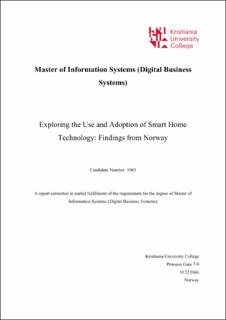| dc.description.abstract | Due to the continuously increasing socio-technical interconnectedness of the world, the massive
increase in connected devices, networks, and systems creates new opportunities for automation
and advanced digitalization like never before. With the perennial presence of smartphones,
mobile technologies are also applied to and combined with new operations, including
automation of domestic lives. Thus, smart and intelligent technologies is a hot topic in the smart
home industry. Researchers have studied motivating and blocking factors for smart home
technology adoptions among consumers. As Norway is a technologically developed country
with generally skilled citizens, the Norwegian smart home market comprises a potential market
for mass adoption of smart home technologies.
To the researcher’s knowledge, there is little new literature on smart home technology adoption
in Norway. Hence, this thesis will study drivers and barriers affecting Norwegian consumers’
intentions to adopt smart home technologies, and the diffusion of smart home adoption in the
Norwegian market. Through a mixed-methods research design, this study provides insights
from both a consumer and a professional perspective obtained from interviews, in addition to
consumer insights from a survey.
The data collection was based on a research model adapted from the Unified Theory of
Acceptance and Use of Technology 2 (UTAUT2) by Venkatesh et al. (2012). The research
model used in this thesis consists of eight constructs which were measured by their effect on
behavioral intention towards adoption smart home technology. The eight constructs include
performance expectancy, effort expectancy, social influence, hedonic motivation, price value,
facilitating conditions, energy management, and security and privacy. Through quantitative and
qualitative data analysis, the findings showed that the strongest drivers that was identified for
smart home technology adoption was hedonic motivation, price value, and social influence.
The lack of awareness and familiarity of smart home technology was identified to be a central
potential barrier to adoption, whereas enhanced market communication and education
regarding smart home technology might contribute to get closer to mass adoption of smart home
technology in Norway. The implications for practice entailed that smart home vendors should
ensure a better communication of smart home technology’s benefits and usefulness towards
consumer and assist in educating the mass market about smart home technology to raise
awareness and familiarity. The implications for research pointed out that there is need for additional research on smart home technology adoption in Norway is needed in the future to
see the development in the market.
This thesis consists of six sections: (1) introduction to the research topic, objectives, and the
research questions, (2) a literature review on existing relevant literature within the field of
study, (3) research method, (4) reporting on empirical findings from the data collection and
analysis, (5) discussion and implications of the respective findings in relation to the literature,
and finally (6) conclusion, limitations, and suggested directions for future research. | en_US |

